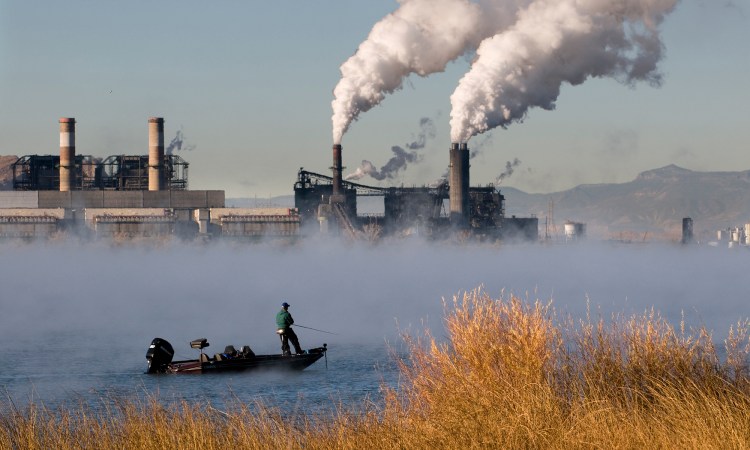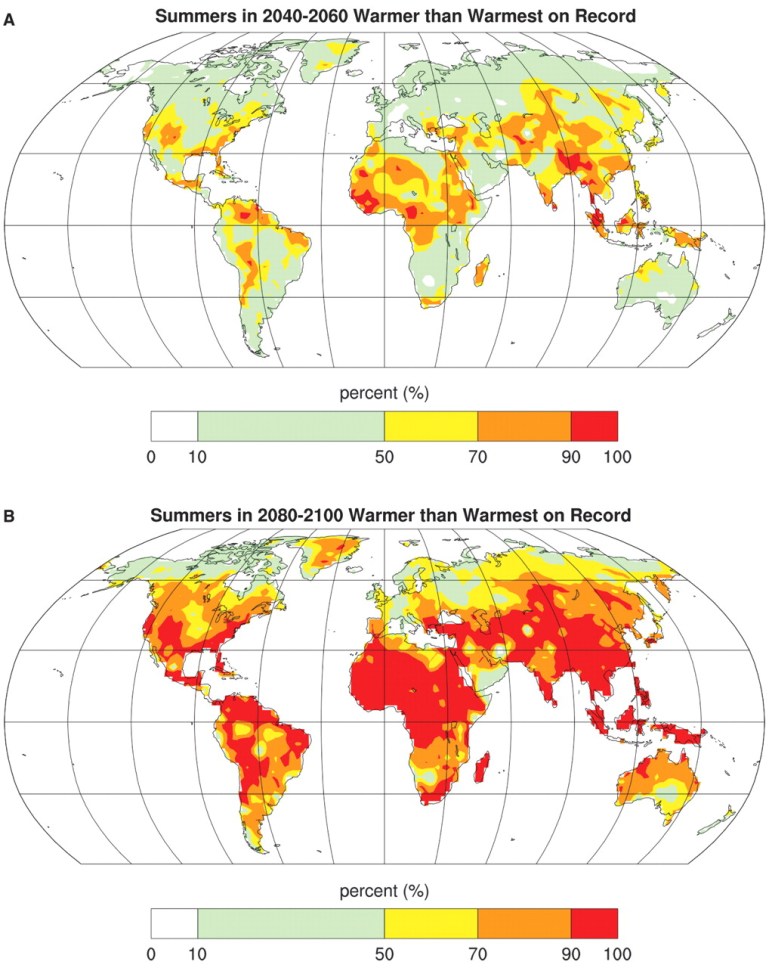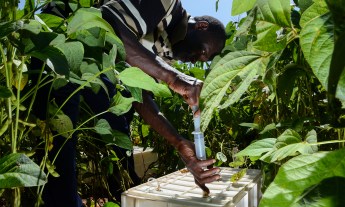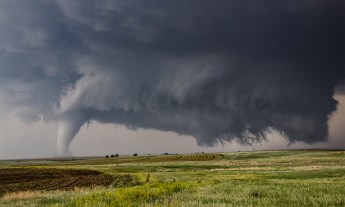
When you think about climate change, what’s the first image that comes to your mind?
Most of us think about a stranded polar bear in a far-flung Arctic landscape, and as a result we humans often feel disconnected from the threat.
But it’s not your imagination — nor the polar bears’ — that the Northern Hemisphere is heating up. In the US alone, by mid-century, almost all cities in the eastern half of the country will have a tripling in the number of extremely hot days above 90 degrees Fahrenheit.
And it’s not just warming land surfaces.
The oceans are heating, we’re seeing more category 4 and category 5 hurricanes, and sea levels are rising. We’re also experiencing disruptions of the hydrologic cycle — the movement of water on, above and below the Earth’s surface — which means we’ll see more severe droughts, floods and fires.
Together, these climate extremes will affect human health through many pathways. From heat waves and pollution to vector-borne diseases and water contamination, here’s why climate change is a public health crisis that affects all of us.
Extreme heat threatens our food supply
Consider the below projections of future summer temperatures. The top map represents predictions for the middle of the 21st century, while the bottom map show temperatures by the end of the 21st century. The areas in red have a 90 percent probability — or greater — of having the hottest summer temperatures in their recorded history.

Extreme heat has serious implications for our food security. If you’re growing crops, there’s a certain climatic envelope that you need to stay within; if it gets too hot or too cold, crops don’t do well. Record-breaking temperatures are predicted to wreak havoc on our world’s food supply. Today, 690 million people are currently at risk for hunger — and this number could double by mid-century. That’s a public health disaster.
Some non-food plants — like poison ivy and ragweed — will actually benefit from higher temperatures and CO2. Since the 1950s, CO2 levels have increased by 27 percent, and places like Wisconsin have warmed more than one degree Fahrenheit. Ragweed plants produce more pollen under these conditions, which is a problem for anyone with allergies or asthma. In fact, in higher latitudes around Wisconsin and into Canada, the ragweed pollen season has already increased by three weeks a year.
Insect- and water-borne diseases will increase
You may have heard of the Aedes aegypti, the mosquito that carries yellow fever, dengue fever and Zika virus. As temperatures warm up, the viral replication rate increases in the mosquito and transmission dynamics increase as well.
We’ve already seen lots of examples of extreme climate conditions leading to major outbreaks of disease. For example, hantavirus in the desert southwestern United States and Rift Valley Fever in Eastern Africa both followed strong El Niño events
But climate change isn’t just about rising temperatures; it’s also about extremes of the water cycle. According to the US climate change research program, heavy rainfall events will be increasing. When it rains, it will really pour because hot air holds more moisture.
Air pollution kills a staggering seven million people every year — that means one in eight deaths worldwide are from air pollution.
Today, we already have trouble handling heavy rain and storm runoff. We get contamination events whenever sewage bypasses sewage treatment and flows straight into our rivers and lakes — we call these “combined sewage overflows“. We studied this phenomenon in the Chicago area, and we’ve predicted that by mid-century there could be a doubling in the number of events of combined sewage overflows because of climate change.
Worse still, places like sub-Saharan Africa — which are the most vulnerable to climate-sensitive diseases like malaria, malnutrition and diarrheal disease — are the least responsible for climate change. If you look at global CO2 emissions, Africa isn’t really contributing to the problem, while wealthy countries like the US are the most responsible for today’s climate. For example, Americans emit six times more CO2 per capita from energy consumption compared to the global average. This may be one of the world’s greatest ethical dilemmas.
The actions we take to mitigate climate change can have enormous health benefits and save money
Let’s look at the energy sector. When we burn oil, coal and gas, we’re not only producing CO2 and greenhouse gas emissions but we’re also emitting dangerous particulate matter, sulfur dioxide and hazardous pollutants that harm human health.
Air pollution kills a staggering seven million people every year — that means one in eight deaths worldwide are from air pollution. That’s twice the number of people who die from AIDS, tuberculosis and malaria — combined. According to the World Bank, air pollution costs the world economy over five trillion dollars every year.
For every ton of CO2 that you avoid emitting, you save $200 because of the health benefits.
Now consider the cost of cleaning up the energy sector. There are some estimates it would cost $30 US to prevent one ton of CO2 emissions. But for every ton of CO2 that you don’t emit, you don’t release dangerous pollutants into the atmosphere. So ultimately, for every ton of CO2 that you avoid emitting, you save $200 because of the health benefits. Oftentimes policymakers are so focused on that extra $30 upfront cost, that they don’t see that the health savings are far bigger.
In fact, the US EPA looked back at the costs and benefits of the Clean Air Act and found that for every dollar invested, it yields $30 in benefits. And if you live in places like China or India where there’s very high pollution, there’s an even greater benefit. Plus, according to the US Energy and Employment report, there’s potential to create one million American jobs in renewable energy — that’s five times more employment compared to jobs in coal, oil and gas.
Cleaning up our energy sector will pay off in many ways
Our over-reliance on fossil fuel-guzzling automobiles is contributing to sedentary lifestyles. Physical inactivity is estimated to kill more than five million people worldwide every year, and over 600,000 people die of heart disease every year in the US alone.
It also turns out, 40 percent of car trips in the US are less than two miles, a distance that’s easily bikeable or walkable. US cities with the highest rates of walking or cycling to work have obesity rates 20 percent lower and diabetes rates 23 percent lower than cities that have the lowest amount of bikeability and walkability. Exercise also reduces the risk of heart disease, cancer, dementia and depression.
In public health, one of the greatest problems that we’ve had to solve is tobacco use — but when cigarette prices rose, youth smoking dropped dramatically.
We did a study for the Upper Midwest region and we asked: “What if we took those short, two-mile car trips off the road in the 11 largest cities of our region? What if just in the summertime — or four months of the year — we turned half of those car trips into bicycle trips?” Swapping tailpipes for pedals could pay huge dividends. We found that by doing this, you would save 1,300 lives every year, and you’d save $8 billion by reducing mortality, absenteeism and hospitalization.
We can save lives by putting a price on carbon
So, how do we get there? In public health, one of the greatest problems that we’ve had to solve is tobacco use — but when cigarette prices rose, youth smoking dropped dramatically.
Climate change is a public health crisis, so like tobacco, it’s time to put a price on carbon. And similar to the tobacco industry, there are many climate change disinformation campaigns that are trying to sow doubt in people about climate science.
But regardless of one’s views on climate change science, we can all support safe routes to schools, physically fit children and adults, cities designed for people not just cars, clean air from low-carbon energy, green jobs, and preserving natural resources for a healthy future.
If we don’t take action, we’re looking at a future with more refugee camps, malnutrition, diarrheal disease and asthma. Confronting the global climate crisis is the greatest human health opportunity of our lifetime, and we can’t afford to sit on the sidelines.
This post was adapted from Jonathan Patz’s TEDxOshkosh Talk. Watch the full talk here:



















